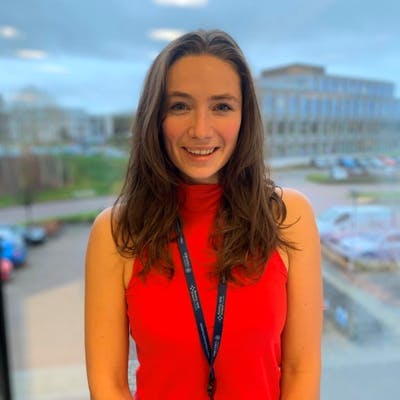Interview with Kate Stanley (original)
- PhD student -

Kate Stanley is a PhD student under supervision of professor Joris Vermeesch in the Laboratory of Cytogenetics and Genome Research (Center for Human Genetics.) To give more insight in what a PhD-research means, we asked her some questions about her research that focuses on how cell free DNA can be used to identify maternal and foetal disorders during pregnancy.
From what we have gathered, you are an Irish student who studied in New York and Oxford. Can you tell us a bit more about your academic background, and why you have decided to come to Leuven for your doctoral research?
“That’s right. I completed my bachelors at Columbia University in New York in Neuroscience & Behaviour. Towards the end of my degree, I switched focus to developmental biology. This is a study of the process by which animals grow and develop. I then worked for two years at Columbia University Irving Medical Center at the Institute for Genomic Medicine with David B. Goldstein. I worked here as the lead genetic analyst for ‘diagnostic prenatal whole exome sequencing.’ This means I mainly did DNA research in which, before the birth of a child, all (known) genes can be analysed at once to find the possible genetic cause of a disorder.” Outside of my clinical responsibilities, I conducted research into rare cases of childhood epilepsies and stillbirth. Later, I decided to pursue a Master of Science in embryology at Oxford University,” Stanley says. “I wanted to better understand genotype-phenotype relationships during development. My previous work relied on statistical associations between genes and disease, but I wanted to better understand the pathophysiology. That is to say, I wanted to better understand how mutations in genes that encode proteins involved in biological processes could result in specific pathologies, in the developing heart or gut, for example.”
“Upon completion of my MSc., I decided I wanted to focus on research. I wanted to tackle larger questions regarding disease pathology rather than focus on individual diagnostic cases. In 2020, I received funding from the Horizon 2020 programme from the European Union after I applied for the ‘MATER-programme: Innovative Training Network in Female Reproductive Care.’ Because of this, I have the opportunity to collaborate across institutions, as well as experience different research environments with distinct expertise. My main host university is KU Leuven, and my co-host university is Karolinska Institute in Sweden.”
Could you explain what a doctoral research is and tell us a bit more about your own research?
“A doctorate, or a PhD, is a 4-year commitment to a research topic. It seems to me that in many cases, a PhD is an exercise in perseverance, wherein you become a more seasoned researcher by learning from your mistakes. Some doctoral research results in a novel finding or a novel technology, which can help the broader community. Negative results, that is studies that do not support the initial hypothesis, can also be beneficial to the broader community, although they are typically more difficult to get published,” Stanley explains.
“My research focuses on cell free DNA, which is DNA that is released from a cell into the blood stream when it dies. Blood cells usually contribute the most to cell free DNA, but it can be derived from many organs in the body, including the liver, as well as from the placenta during pregnancy, and from tumour cells in the event of cancer. My work focuses on how cell free DNA can be used to identify maternal and foetal disorders during pregnancy.”
We have been informed that you are also participating in a study on rare genetic disorders. What does this research entail?
“Of course. The diagnostic odyssey refers to the often very long series of tests a patient must go through before receiving a genetic diagnosis. This is especially true for rare disorders. Even after whole exome sequencing uncertainty surrounding a diagnosis can remain. As mentioned previously, whole exome sequencing is the broadest search for genetic variants that may cause a disorder. Suspicious variants that do not have enough evidence supporting pathogenicity are referred to as ‘variants of uncertain significance’ (VUS). Our research is important because we attempt to offer a new way to validate this class of variants in a small set of rare developmental disorders,” Stanley mentions. “We mostly focus on ‘chromatinopathies’ – these are single gene disorders caused by mutations in epigenetic regulators. These epigenetic regulators, sometimes called ‘readers’, ‘writers’ and ‘erasers’, help to package the genome in different ways in different cell types in order for the cells to perform different functions. We expect that mutations in these genes will have broad effects on the conformation of the genome, or ‘epigenome,’ which may be reflected in cell free DNA patterns.”
Both clinical genetics at the CME and researchers are included in this important study. Kate Stanley herself is a lead PhD researcher under supervision of PI Joris Vermeesch.
That sure sounds interesting! Could you tell us more about the challenges you and your team face?
“Recruiting patients with rare developmental disorders is a challenge, because there are so few patients per disorder. Furthermore, it is often difficult for families to schedule an appointment to come into the hospital. Moreover, blood draws can be uncomfortable for the often younger patients, and technically challenging for the doctor and study nurse,” Kate says. “We are currently in the beginning phases of the research. It is largely exploratory and we hope to use free cell DNA, extracted from the patient’s blood, to identify ‘epi’-signatures of disease. This would be a minimally invasive test that could validate the impact of variants found during exome sequencing.”
Thank you for your time. We are looking forward to further developments!
This interview was written by Marijke van Beers, intern at the CME. The interview was originally in English.
